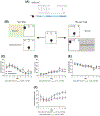DCC-related developmental effects of abused- versus therapeutic-like amphetamine doses in adolescence
- PMID: 31192517
- PMCID: PMC8301742
- DOI: 10.1111/adb.12791
DCC-related developmental effects of abused- versus therapeutic-like amphetamine doses in adolescence
Abstract
The guidance cue receptor DCC controls mesocortical dopamine development in adolescence. Repeated exposure to an amphetamine regimen of 4 mg/kg during early adolescence induces, in male mice, downregulation of DCC expression in dopamine neurons by recruiting the Dcc microRNA repressor, microRNA-218 (miR-218). This adolescent amphetamine regimen also disrupts mesocortical dopamine connectivity and behavioral control in adulthood. Whether low doses of amphetamine in adolescence induce similar molecular and developmental effects needs to be established. Here, we quantified plasma amphetamine concentrations in early adolescent mice following a 4 or 0.5 mg/kg dose and found peak levels corresponding to those seen in humans following recreational and therapeutic settings, respectively. In contrast to the high doses, the low amphetamine regimen does not alter Dcc mRNA or miR-218 expression; instead, it upregulates DCC protein levels. Furthermore, high, but not low, drug doses downregulate the expression of the DCC receptor ligand, Netrin-1, in the nucleus accumbens and prefrontal cortex. Exposure to the low-dose regimen did not alter the expanse of mesocortical dopamine axons or their number/density of presynaptic sites in adulthood. Strikingly, adolescent exposure to the low-dose drug regimen does not impair behavioral inhibition in adulthood; instead, it induces an overall increase in performance in a go/no-go task. These results show that developmental consequences of exposure to therapeutic- versus abused-like doses of amphetamine in adolescence have dissimilar molecular signatures and opposite behavioral effects. These findings have important clinical relevance since amphetamines are widely used for therapeutic purposes in youth.
Keywords: Netrin-1; Prefrontal cortex; cognitive control; guidance cues.
© 2019 Society for the Study of Addiction.
Conflict of interest statement
DISCLOSURE/CONFLICT OF INTEREST
The authors declare no conflict of interest.
Figures




Similar articles
-
Amphetamine in adolescence disrupts the development of medial prefrontal cortex dopamine connectivity in a DCC-dependent manner.Neuropsychopharmacology. 2015 Mar 13;40(5):1101-12. doi: 10.1038/npp.2014.287. Neuropsychopharmacology. 2015. PMID: 25336209 Free PMC article.
-
Non-Contingent Exposure to Amphetamine in Adolescence Recruits miR-218 to Regulate Dcc Expression in the VTA.Neuropsychopharmacology. 2018 Mar;43(4):900-911. doi: 10.1038/npp.2017.284. Epub 2017 Nov 20. Neuropsychopharmacology. 2018. PMID: 29154364 Free PMC article.
-
Resilience to amphetamine in mouse models of netrin-1 haploinsufficiency: role of mesocortical dopamine.Psychopharmacology (Berl). 2015 Oct;232(20):3719-29. doi: 10.1007/s00213-015-4032-9. Epub 2015 Aug 12. Psychopharmacology (Berl). 2015. PMID: 26264903
-
The Netrin-1/DCC guidance system: dopamine pathway maturation and psychiatric disorders emerging in adolescence.Mol Psychiatry. 2020 Feb;25(2):297-307. doi: 10.1038/s41380-019-0561-7. Epub 2019 Oct 28. Mol Psychiatry. 2020. PMID: 31659271 Free PMC article. Review.
-
The Netrin-1/DCC Guidance Cue Pathway as a Molecular Target in Depression: Translational Evidence.Biol Psychiatry. 2020 Oct 15;88(8):611-624. doi: 10.1016/j.biopsych.2020.04.025. Epub 2020 May 11. Biol Psychiatry. 2020. PMID: 32593422 Free PMC article. Review.
Cited by
-
Neurobehavioral changes arising from early life dopamine signaling perturbations.Neurochem Int. 2020 Jul;137:104747. doi: 10.1016/j.neuint.2020.104747. Epub 2020 Apr 20. Neurochem Int. 2020. PMID: 32325191 Free PMC article. Review.
-
Unique effects of social defeat stress in adolescent male mice on the Netrin-1/DCC pathway, prefrontal cortex dopamine and cognition (Social stress in adolescent vs. adult male mice).eNeuro. 2021 Feb 12;8(2):ENEURO.0045-21.2021. doi: 10.1523/ENEURO.0045-21.2021. Online ahead of print. eNeuro. 2021. PMID: 33619036 Free PMC article.
-
Low-cost conditioned place preference setup including video recording and analysis of behaviour.MethodsX. 2020 Apr 25;7:100899. doi: 10.1016/j.mex.2020.100899. eCollection 2020. MethodsX. 2020. PMID: 32405466 Free PMC article.
-
Mesocorticolimbic Dopamine Pathways Across Adolescence: Diversity in Development.Front Neural Circuits. 2021 Sep 8;15:735625. doi: 10.3389/fncir.2021.735625. eCollection 2021. Front Neural Circuits. 2021. PMID: 34566584 Free PMC article. Review.
-
Gains and Losses: Resilience to Social Defeat Stress in Adolescent Female Mice.Biol Psychiatry. 2024 Jan 1;95(1):37-47. doi: 10.1016/j.biopsych.2023.06.014. Epub 2023 Jun 23. Biol Psychiatry. 2024. PMID: 37355003 Free PMC article.
References
-
- Spear LP. The adolescent brain and age-related behavioral manifestations. Neurosci Biobehav Rev. 2000;24(4):417–463. - PubMed
Publication types
MeSH terms
Substances
Grants and funding
LinkOut - more resources
Full Text Sources

